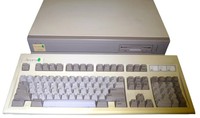Acorn A4000
| Home > Browse Our Collection > Computers > Acorn Computers > Acorn A4000 |
|
The Acorn AGC10 A4000 was a slightly cheaper cut down A5000, with a shorter case, one expansion slot and an ARM250 processor. Curiously, the machine had its floppy and hard drive fixed to the chassis with a wire clip which meant these could be quickly replaced without tools, whereas replacing the hard disk on the A5000 was a more fiddly operation requiring the expansion slot plane and the whole chassis holding the drives to be removed. Many of the features (ARM250, VGA screen modes, RISC OS 3) of this model were implemented into the lower end A3010 and A3020 computers. Our unit is very unique in that it is in pristine condition and is complete with all the original packaging and box - all immaculate. Complete with software, manuals and keyboard. Serial Number 0000001 as can be seen from photographs of the unit and the box. The keyboard is model no: E 03610Acorn and has serial no: 237A522 We are extremely grateful to Martin Lassetter who very kindly donated the system. Press Release: Driven by the new ARM250 chip, purpose designed for Acorn by Advanced Risc Machines Ltd, and running at 12MHz, the new A4000 delivers 6 MIPS performance - which is 1.4 times faster than a 33MHz 386DX. The A4000 has 2MB of RAM expandable to 4MB on the circuit board; VGA graphic support comes as standard, as do the wide range of Acorn screen modes. There is a 2MB floppy disc drive which, with RISC OS 3, can automatically detect and use Acorn and PC discs. Another major feature of this three box solution is the newly restyled keyboard. The A4000, with its industry standard 80 MB IDE hard disc, is housed in a slimline case which complements the A5000's styling. It has internal support for both Econet and Ethernet without compromising the main expansion slot." Manufacturer: Acorn Comment on This Page Acorn A4000 Manuals:
Magazines RELATED to Acorn A4000 in our LibraryOther Systems Related To Acorn A4000:This exhibit has a reference ID of CH4757. Please quote this reference ID in any communication with the Centre for Computing History. |
Click on the Image(s) For Detail
|




























